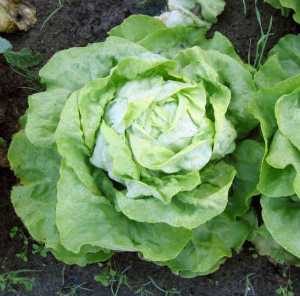How to Grow Lettuce – A Guide to Growing Lettuce
 Lettuce
Lettuce
Lettuce is an easy plant to grow almost all year-round (under cover during colder months). It can be grown in pots and window boxes as well as the open ground, and is generally happy at close spacings. Some varieties are pretty enough to go in the ornamental garden too.
There are 4 different types of lettuce:
- cos (a little slower to mature than butterheads, with crisp oval hearts)
- crisphead / iceberg (solid heads and few outer leaves)
- butterhead (quick to mature, more tolerant of poor conditions, with soft leaves and loose heart)
- looseleaf (do not heart up and are ideal for ‘cut and come again’ picking)
Recommended Varieties
- Little Gem is probably the best known cos lettuce, with other varieties including Winter Density, Romaine and Winter Gem
- Crisphead varieties include the traditional favourite Webbs Wonderful
- All the Year Round is a well-known butterhead variety; Sangria has red-tinged leaves, and Tom Thumb is small and quick to mature
- Looseleaf varieties include Salad Bowl (red and green), Lollo rossa (red), and mixed salad leaf types.
- You can also buy mixed packets of salad leaves or create your own from e.g. mizuna, mustard, oak leaf lettuce, basil, rocket and raddichio
- Alternatives salad leaves include corn salad or lamb’s lettuce, Claytonia or winter purslane and land cress
Pests and Problems
- Slugs and aphids are frequent pests of lettuces (aphids can be washed off), although birds sometimes enjoy pecking at the leaves too
- Lettuces bolt very easily; if this happens, simply pull the plant out
- Brown edges to the leaves indicate irregular watering or weather that is too hot
Sowing & Growing
- Summer varieties can be sown in succession from February to July – sowing a little and often will help to avoid gluts and will also provide a constant supply of fresh plants when the older ones bolt or are harvested
- Harvest from April to September
- For winter / spring plants, sow hardy varieties in autumn. In cooler areas, protection over the winter may be needed
- Lettuce prefers soil with adequate organic matter, it must not be acidic, and needs to be kept moist during the growing season
- Sow thinly in modules or small pots of multi-purpose compost, thinning to 1 plant per module / pot when the seedlings are through. Harden off and transplant to final growing place after 2-3 weeks, and sow some more seeds in the (cleaned) pots / modules.
- Plant out in sunny or partially shaded spots (in the height of a good summer, lettuce is happier in the coolness of partial shade)
- Alternatively, sow loose leaf varieties outdoors by scattering the seed thinly in a small area and covering lightly. Sow a further patch 2 weeks later. The seeds should be ready for harvest in 6-8 weeks.
Harvesting, Eating & Storing
- Cut looseleaf varieties with scissors about 5 cm above the ground
- For the other lettuces, pull up the entire plant and place it in a cool place in a vase of water to keep it fresh. Harvest leaves as desired.
- Lettuce can be cooked e.g. as soup, or often with peas, This is useful as a way to use up a glut.



